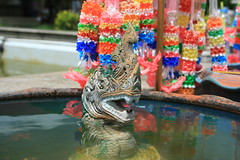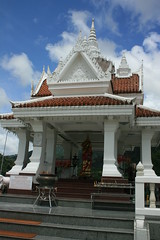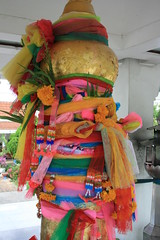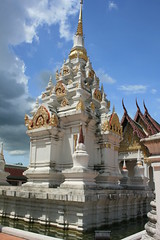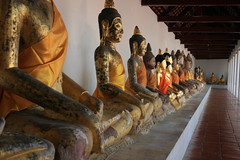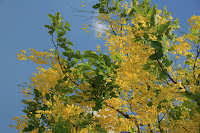One of the best museums in Thailand is the relatively new
Museum Siam (มิวเซียมสยาม), located at the southern end of the Rattanakosin island in the former building of the Ministry of Commerce. I
learned about it from the great website Tour Bangkok Legacies, where a lot of special places within Bangkok off the beaten track are featured. While it has only few original antique items - if you prefer to see that better go to the National Museum in the north of Rattanakosin -the way of presenting the history of Siam/Thailand is much easier accessible than in the older style presentation of the National Museum. And one big advantage of the latter - here photography in the museum is not only allowed, the clerk who sent me to the first room even explicitly notified me that I can take photos of everything. Also many exhibits are free to be touched for completely experiencing the items.
The first room is a big auditorium, where a
short movie is shown as an introduction to the main theme of the museum - why is typically Thai. The movie also introduces the emblem of the movie, a red character in a frog style standing position. One will find many variations of the emblem in the later rooms, but very nice are those hanging in the staircase one has to go up to the third floor. But before the staircase one enters the first exhibit room, which is kind of a wild collage of all the cliches of typically Thai - Muay Thai, temple dancers, a spirit house, a street food carriage and of course inevitably a Tuk Tuk, ready to sit inside to pose.

Starting in the third floor with the early history - starting way before prehistory with the dinosaurs found in the Northeast, racing from the Lampang Man (
Homo erectus) and the
prehistoric remains, reaching the mostly mythological Suvarnabhumi country as the first main stop. Since Suvarnabhumi more refers to the whole South East Asia, on what later became Thai soil it had the first city states of the Dvaravati culture, which later became replaced by the first Thai city states.
With Ayutthaya being the most successful of these city states, the next room features beautiful boats hanging in the center and several dioramas depicting scenes from various times in this city - a royal cremation, a market, even a Christian church built by the western missioners. Another one room focuses on Buddhism, and one on the culture of war in these times.
One floor down the exhibitions continues with the map room, not only showing old maps like the famous
Carte du Royaume de Siam et des Pays Circonvoisins and the first modern cartographic map of McCarty finished in 1897, but even more notable the depiction of the change of the boundaries of Siam is critical of the nationalistic use of these maps and - of course hardly possible in such a short presentation - shows many of the main points of the highly recommended book "
Siam Mapped".
The various cultures in Siam at the beginning of the 20th century are shown in small windows with audio and video, and small items typical of them - I photographed the Chinese as the most iconic of them.
The contrast between the farming communities and the modern technology coming into Siam at that time is shown next, including the first postbox of Siam. Next step is already the nationalist Phibun regime, again (at least in English) the description of the displayed items is notable critical of the ideas of these times, where anyone who disagreed with the government policies was termed non-Thai.
A 1960s TV station where one can try to sit as a news announcer in front of the camera is next, and a bar of the about the same time. A time tunnel into the future is then the exit of the exhibition.
The only point I could criticize about the museum is the pricing - like many venues it does the infamous double pricing, whereas foreigners pay 300 Baht, while Thai only pay 100 Baht. It is worth the inflated price nevertheless, but would probably attract even more foreigner with a more fair pricing - and an English website would definitely help to spread to word better, inside the museum everything is bilingual already. Whereas many museums in the western countries have their exit directly into the museum shop, I completely failed to find the museum shop here and wondered why there's no merchandise with that nice emblem. Only after I checked the website again later I noticed that there is a museum shop, but it must be quite well hidden.
Also notable is the fact that this museum is the first one in Thailand which is present in the Web 2.0 - they're quite active on
Facebook as well as
Twitter; and there are two branch museums planned already, one in Lampang and one in Chanthaburi. When I come in either of these cities these museums will definitely be on my itinerary.
 So far the best local museum I have visited in Thailand has been the one in Nonthaburi. Not only it seems it has better funding than those local museums in the Bangkok district, the location in the historic province hall complex right in the center of Nonthaburi, right at the Nonthaburi pier on the Chao Phraya river. The only major drawback - photography is not allowed inside, so I sadly cannot show the exhibits in here. However, the webmaster of Tour Bangkok had been allowed to photograph, so in his long review of the museum one can find both outside and inside views. In fact, it was that site which made me aware of this museum.
So far the best local museum I have visited in Thailand has been the one in Nonthaburi. Not only it seems it has better funding than those local museums in the Bangkok district, the location in the historic province hall complex right in the center of Nonthaburi, right at the Nonthaburi pier on the Chao Phraya river. The only major drawback - photography is not allowed inside, so I sadly cannot show the exhibits in here. However, the webmaster of Tour Bangkok had been allowed to photograph, so in his long review of the museum one can find both outside and inside views. In fact, it was that site which made me aware of this museum. The museum only covers few rooms on two floors, other parts of the complex are still used as a kindergarten or seem to be empty. However, from a map placed near the entrance there are plans to enlarge the museum a lot and cover many more parts of the building. This building did not just contain the province hall, but also had the district office of Mueang Nonthaburi district and the provincial court - not that different from the current governmental center of Nonthaburi. One of the exhibitions rooms is thus on the history of the building, too bad I could not photograph the map which office was in which part of the complex.
The museum only covers few rooms on two floors, other parts of the complex are still used as a kindergarten or seem to be empty. However, from a map placed near the entrance there are plans to enlarge the museum a lot and cover many more parts of the building. This building did not just contain the province hall, but also had the district office of Mueang Nonthaburi district and the provincial court - not that different from the current governmental center of Nonthaburi. One of the exhibitions rooms is thus on the history of the building, too bad I could not photograph the map which office was in which part of the complex. The most beautiful rooms are on the top floor, one explaining the traditional main occupation in the province - pottery. It has figurines explaining the way the mud was turned into bowls and pots, and these figurines are of course also made by pottery. There are also two videos to be seen, and most fascinating for our daughter the magic screen showing a scene of pottery loaded into boats. Most interesting for me was the room focusing on the symbols of the province, featuring a large provincial seal in center. Inside the cabinet were the coins with the seal, the stamps, and also an antiquarian booklet compiled by the province administration with history and data on the province. I would love to have a facsimile reprint of that booklet - maybe in the later development of the museum a gift shop will be added, and that would be a great special item to sell there then.
The most beautiful rooms are on the top floor, one explaining the traditional main occupation in the province - pottery. It has figurines explaining the way the mud was turned into bowls and pots, and these figurines are of course also made by pottery. There are also two videos to be seen, and most fascinating for our daughter the magic screen showing a scene of pottery loaded into boats. Most interesting for me was the room focusing on the symbols of the province, featuring a large provincial seal in center. Inside the cabinet were the coins with the seal, the stamps, and also an antiquarian booklet compiled by the province administration with history and data on the province. I would love to have a facsimile reprint of that booklet - maybe in the later development of the museum a gift shop will be added, and that would be a great special item to sell there then. As I could not photograph the inside, I tried to catch many views of the wooden structures of the building, beautifully carved. Too bad all the modern administrative offices have a much more boring and plain building style, this old building has much more charm - but obviously much harder to maintain.
As I could not photograph the inside, I tried to catch many views of the wooden structures of the building, beautifully carved. Too bad all the modern administrative offices have a much more boring and plain building style, this old building has much more charm - but obviously much harder to maintain. While visitors of the museums are allowed to park their car inside the complex, maybe the best way to go the museum is to take the Express boat - when disembarking from the boat at the final stop upriver one is directly at the museum already, and though it may take longer than by car the boat travel is the cheapest and also most scenic way to travel there. Maybe I will try out this way for a return visit, when the phase one in the master plan is finished there'll be many more rooms with interesting exhibits - only area A was finished in early 2010.
While visitors of the museums are allowed to park their car inside the complex, maybe the best way to go the museum is to take the Express boat - when disembarking from the boat at the final stop upriver one is directly at the museum already, and though it may take longer than by car the boat travel is the cheapest and also most scenic way to travel there. Maybe I will try out this way for a return visit, when the phase one in the master plan is finished there'll be many more rooms with interesting exhibits - only area A was finished in early 2010.




